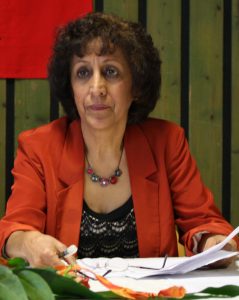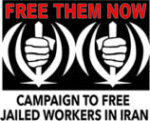Shahla Daneshfar

The labor movement in Iran is undergoing a transformation. Labor protests in Iran are widespread and in a growing process. These protests have become more radical every day and we can see protests of workers are against poverty, discrimination, inequality, state embezzlement, unemployment, wages that are severely below the poverty line, the Islamic government’s violations of people and their livelihoods, and generally worker protests for a decent humane life.
In recent years, long-term strikes in Iran have become routine and sometimes have lasted for a month or even more. More and more large industrial centres are striking every day despite the fact that gatherings and organizations are prohibited in Iran. Workers and protesters gather every day because of their urgent demands. They march in the middle of the city and chant and shout out for their wishes to be heard.
In Iran, workers and teachers are deprived of the right to organize, but they have independently and by their own formed several organisations such as the Free Trade Union of Workers of Iran, The Vahed (city bus company) Syndicate, the Haft Tapeh Sugarcane Syndicate, the Coordination Committee for the Establishment of Workers ‘Organizations, the Follow-up Committee for the Establishment of Workers’ Associations, the Kermanshah Electric and Metal Association, the Labor Defenders ‘Association, the Alborz Painting Workers Syndicate, the Workers’ Union for Electric and Metal Workers and Trade Unions in various fields of construction and bakery, and other organizations like the Teachers’ Association and so on.
Today, with the help of social media, workers, teachers, and other protesting sections of the society y have created their own campaign groups in networks such as Telegram, which allow them to be organized on a large scale. In these groups, they have been discussing about their conditions and their demands every day, and they are getting more and more united around these demands. In these social media groups, they also decide the forms of their protests and how to best continue and succeed them. They call for rallies and protests, and their calls are being responded more broadly and socially every day. Gatherings can include three to four thousand people daily protests against the Islamic government by gatherings in front of the Islamic parliament, or the President Rohany’s office, the Ministry of Labor and Social Security, Governorates and various government agencies.
A remarkable phenomenon in the last two years is the workers protests on a national scale. Workers, teachers, retirees in their social media groups are more organized every day. In these groups, they mobilize their forces and call for protests for specific days. As a result, protests have become more global this year which have provided the basis for further demonstrations as people gain more confidence and momentum in their actions. An example is a large number of retirees who gathered several times in recent months in large numbers and were very organised and well articulated.
Another remarkable phenomenon is the family members participation in workers protests. This gives a more social and powerful dimension to labor protests.
Common demands and slogans in protests is another outstanding feature of the today protests in iran. the similarity of slogans of slogans of various sectors of society, including workers, teachers, retirees and students is very clear. As mentioned before protest against poverty, discrimination, inequality, embezzlement and for having a decent human life is widespread.
A clear evidence of the rising popularity of protests in Iran is the officials’ remarks about the size of the protests: In the year 2015, a government official in Kerman declared the number of labor protests in this province as 6500 in the first six months of the year. Also, according to published official reports, the number of labor protests in 2016 increased significantly compared to 2015 and 2014. Statistics over the course of 2016 shows that workers protested in 653 production and service centres for their demands, which was an increase by about 27 percent compared to year 2015. In 2016 there were 1264 workers’ protests, which mean that there were more than three protests happening every day. It is noteworthy that the workers’ protests grew in 2016 and has been growing in 2017. In August 2017 Sardar Kiomars, Azizi, the provincial police commander told reporters that since the beginning of the year, 118 gatherings have taken place in the province, a 240-percent increase from the same period last year.
Another important issue is the daily protests of the workers are against the unpaid wages and against expulsion from work. In Iran, the wages of a worker, a teacher and a retired person are not paid for months and this trend have become a normal policy by almost all employers and government. Workers see this as a crime and robbery and stand against it. The centrepiece of the labor protests demands in Iran are the increase in wages, against unpaid wages and layoffs, and for official and direct employment by employers instead of the middle men and brokers. Other main demands are equal pay for equal work, free education, free healthcare , the right to organize and other basic rights of the people .
One of the most prominent protests of the workers in Iran is about the authorities astronomical thefts and embezzlements and mega salaries which been exposed on every day basis.
– People also are protesting the huge funds spent on terrorist policies in the region, including in Syria. Slogans like ‘an embezzlement less, our problem is solved’, ‘Leave Syria, think about us,’ ‘Astronomical salaries, public misery’, have become common slogans that have turned into protests by workers, teachers, retirees and all people. These slogans challenge the entire government. Labor protests in Iran are radical, leftist, and humanistic, and challenge the discrimination and inequality of ruling capitalism. The labor movement in Iran is an active factor that directly affects the whole political atmosphere of the society. In Iran, various protest movements such as women’s’ rights, environmental care, the rights of the children, against capital punishment, for the release of political prisoners, are increasingly more organized every day. The labor movement has much impact on the course of the political developments in society.
Campaign to Free Jailed Workers (Free Them Now)
Shahla.daneshfar2@gmail.com

